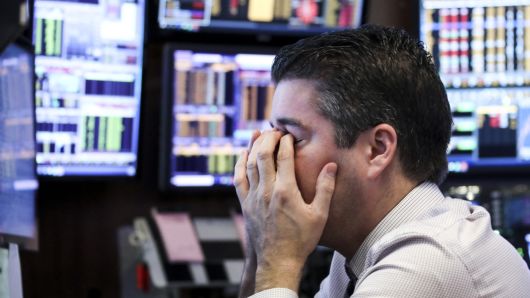
Xinhua News Agency | Getty Images
A trader works at the New York Stock Exchange in New York, the United States, Dec. 4, 2018.
What a difference a year makes.
Last December, investors piled into bank stocks after the Trump administration’s corporate tax cuts added billions of dollars to earnings estimates for 2018. Rising interest rates, low loan losses and easing regulations were other reasons the sector was supposed to outperform this year.
Now analysts have begun to lose faith in the industry after their recommendations for 2018 fell flat. Bank have been hammered lately amid worries about the U.S. economy as the yield curve has flattened – with sections of the curve inverting this month – signalling diminished expectations for future growth. The KBW Bank index is down more than 15 percent in 2018, compared to the 1.3 percent decline of the S&P 500.
“As we look to 2019, we do not see enough positive catalysts emerging—besides the group simply having a discounted valuation—that could move the group higher,” KBW analysts led by Brian Kleinhanzl wrote in a research note Tuesday.
So the firm cut its recommendation on banks to “market weight” from “overweight” and specifically downgraded shares of Bank of America and Morgan Stanley. It also lowered banks’ earnings estimates for 2019 and 2020 and said it expected other analysts to do the same. KBW’s move follows a similar one by independent research firm CFRA last week.
Banks have been punished over investor fears that the U.S. economy is nearing the end of a long boom. Worries began earlier this year as the yield curve – the difference between rates on short term and long term U.S. bonds – flattened, indicating bank profits could be crimped (banks borrow on the short end and lend at the long end).
Portions of the yield curve actually inverted this month, prompting Morgan Stanley’s chief U.S. equity strategist to say that there was a 50 percent chance of an earnings recession for American companies next year.
Further Federal Reserve rate hikes, coming as soon as this month, are seen as hurting bank profits because borrowers may have a harder time repaying debts. Loan growth is expected to be anaemic at 1.9 percent, which competition for deposits will crimp banks’ profit margins starting in 2020, according to Kleinhanzl.
“Higher interest rates, ongoing trade wars, and our forecast for slowing economic growth creates an environment where it is difficult for universal bank stocks to outperform,” he wrote.
 EU News Digest Latest News & Updates
EU News Digest Latest News & Updates



